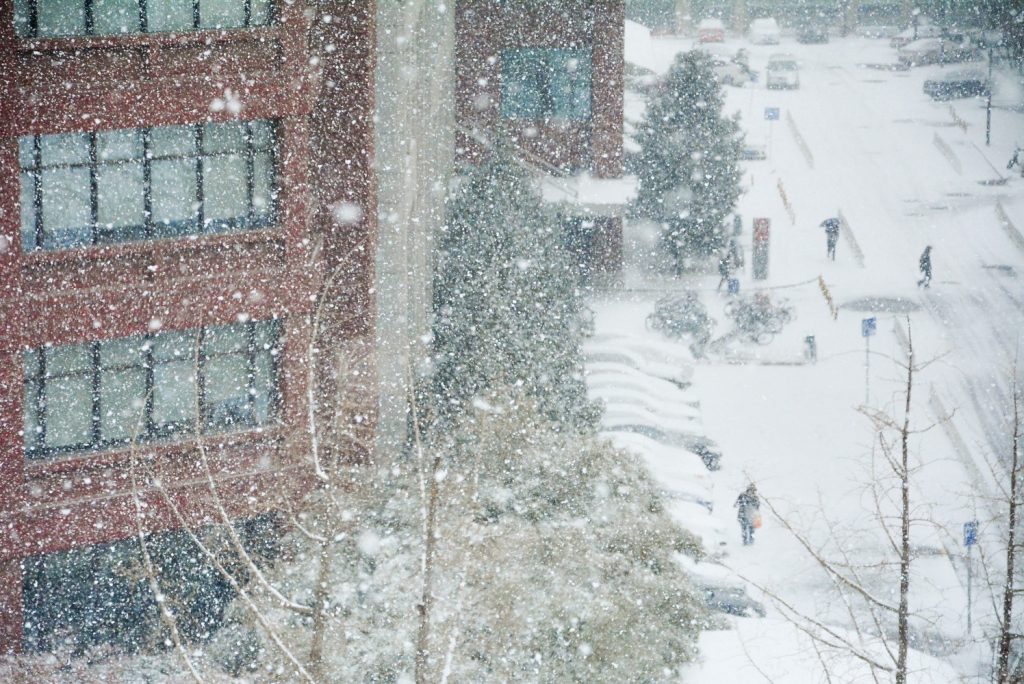In the Aftermath of Omaha’s Latest Blizzard, Here Are Some Safety Tips

This year, the Midwest has been experiencing what some people are calling a “polar vortex”—a cold snap that has taken at least 21 lives across the United States. This past weekend in Nebraska, we had a blizzard that kicked up heavy snow and reduced visibility to near-zero. These whiteout conditions closed Interstate 80 and caused numerous vehicle crashes.
It’s our snowiest February on record, and on Monday, February 25, 2019, we saw a record low temperature of -7 degrees in Omaha. We’re expecting to see highs in the teens and lows dipping back into the negatives this week!
Last weekend, we also had a serious storm, whose aftermath had fire engines sliding down hills and firefighters shuffling across streets on their knees. KETV reported an increase in trauma-related injuries at CUMC-Bergan Mercy ER, and this trend is expected to continue as long as the cold weather lasts. “”We’ve seen wrist fractures, ankle fractures, we’ve seen a lot of ankle sprains,” Dr. Dipti Agarwal said.
We’re sure the University of Nebraska Medical Center has seen a similar number of slip-and-fall victims, and our law firm would like to share some tips to keep fellow Omahans warm and fall-free.
Layering Up for the Cold
It only takes three to 15 minutes to develop frostbite in subzero temperatures. Hypothermia can set in when the body drops from its regular 98 degrees to 95 degrees. This can “freeze” your mental alertness and you can go downhill quickly, so stay inside and stay warm.
We all know to layer when it gets cold outside, but what about when it gets really, really cold? Layering is still the key, but here are a few other tips from a polar researcher, as elicited by Vox:
- Wear loose layers to keep air circulating and increase your insulation. This will keep you warmer, and allow you to move. If you have tight or restrictive clothing that inhibits your movement, your circulation will suffer, and you’re more at risk of frostbite. The same thing is true for your feet—don’t pack the socks so tightly that they can’t move around in your boots.
- Avoid cotton and wear a moisture-wicking fabric. The layers closest to your body should be the thinnest, and thicker layers should go over that. Your top layer should be a waterproof windbreaker material, and fur (faux or real) can reduce “friction” and cut down on the windchill factor.
- Wear a hat and protective glasses. A good deal of body heat is lost through the head, and when you’re outside, it can even be lost between the top of your sunglasses and your hat! Layering a baseball cap underneath a winter cap is recommended to trap that heat.
- Don’t forget the sunscreen. The glare of the sun on the ice and snow can cause burns, even on the underside of your nose! Put on a strong sunscreen (SPF 30 or higher, and waterproof) and moisturize your skin when you’re indoors.
Protecting Yourself in a Fall
An icy slip-and-fall only takes a split second. We recommend practicing these techniques in advance, if you can!
- Take it slow. Move forward slowly and cautiously, testing the ground with each step. Make sure your vision is as clear as it can be, and if you can’t see what’s ahead of you, stop and assess. Be aware of your surroundings, and concentrate on the path in front of you.
- Wear the right shoes. The more traction your footwear has, the better. Slip-on cleats, snow covers, or hiking poles may be a good idea.
- Tuck your chin into your chest. This is a trick gymnasts use while falling, and it’s supposed to protect the spinal cord—and may also keep your head from hitting the ground, if you fall backward.
- Cover your head and neck. The greatest danger you face is receiving a traumatic brain injury in a fall. If you can, turn your head away from the direction of the fall.
- Bend your elbows and knees. Try not to lock your body up. Loosen your limbs, and it may soften the impact.
- Try to land on muscle, not bone. Landing on your back, buttocks, or thighs is less likely to cause broken bones.
After you’ve fallen, take a moment to relax and try to assess your injuries, if any. Move slowly, and if a part of your body is causing you serious pain, don’t move it—get medical treatment right away. Cell service may be tricky after this blizzard, so communicate your needs to other passersby to make sure you get the help you need.
From Bottlinger Law L.L.C., we hope these tips keep you warmer and safer in this polar vortex—however long it lasts. Remember, if you have a legal question having to do with your injury, you can call our Omaha slip-and-fall lawyer at (402) 505-8234.
Bottlinger Law
Consultation Form
Our legal team is ready to help. Please fill out the form below to set up a free consultation with the Bottlinger Law team.